Battle of Bannockburn
Coordinates: 56°05′31″N 3°54′54″W / 56.092°N 3.915°W
| Battle of Bannockburn | |||||||
|---|---|---|---|---|---|---|---|
| Part of the First War of Scottish Independence | |||||||
 This depiction from the Scotichronicon (c.1440) is the earliest known image of the battle. King Robert wielding an axe and Edward II fleeing toward Stirling feature prominently, conflating incidents from the two days of battle. | |||||||
| |||||||
| Belligerents | |||||||
|
|
| ||||||
| Commanders and leaders | |||||||
|
|
| ||||||
| Strength | |||||||
| 5,000[1]–10,000[2] | 13,700[3]–25,000[4] | ||||||
| Casualties and losses | |||||||
| 400[5]–4,000[6] |
700 cavalry[7] 4,000[8]–11,000 infantry[9] | ||||||
The Battle of Bannockburn (Scottish Gaelic: Blàr Allt nam Bànag or Scottish Gaelic: Blàr Allt a' Bhonnaich) 24 June 1314 was a significant Scottish victory in the First War of Scottish Independence, and a landmark in Scottish history.
Stirling Castle, a Scots royal fortress occupied by the English, was under siege by the Scottish army. The English king, Edward II, assembled a formidable force to relieve it. This attempt failed, and his army was defeated in a pitched battle by a smaller army commanded by the King of Scots, Robert the Bruce.
Background
The Wars of Scottish Independence between England and Scotland began in 1296 and initially the English were successful under the command of Edward I, having won victories at the Battle of Dunbar (1296) and at the Capture of Berwick (1296).[10] The removal of John Balliol from the Scottish throne also contributed to the English success.[10] The Scots had been victorious in defeating the English at the Battle of Stirling Bridge in 1297. This was countered, however, by Edward I's victory at the Battle of Falkirk (1298).[10] By 1304 Scotland had been conquered, but in 1306 Robert the Bruce seized the Scottish throne and the war was reopened.[10]
Edward II of England came to the throne in 1307 but was incapable of providing the determined leadership his father Edward I had shown, and the English position soon became more difficult.[10] Stirling Castle was one of the most important castles held by the English, as it commanded the route north into the Scottish Highlands.[10] It was besieged in 1314 by Robert the Bruce's younger brother, Edward Bruce, and an agreement was made that if the castle was not relieved by mid-summer it would be surrendered to the Scots.[10]
The English could not ignore this challenge and prepared and equipped a substantial campaign. The English army numbered about 2,000 heavily armoured cavalry and 15,000 infantry, many of whom were likely armed with longbows.[10] The Scottish army probably numbered between 7,000-10,000 men, including no more than 500 mounted forces.[10] Unlike the English, the Scottish Cavalry were probably unequipped for charging enemy lines and only suitable for skirmishing and reconnaissance.[10] The Scottish infantry were likely armed with axes, swords and pikes, and only included a few bowmen among them.[10]
The precise size of the English force relative to the Scottish forces is unknown, but modern researchers estimate that the Scottish faced English forces from one-half to two or three times their size.[11]
Prelude
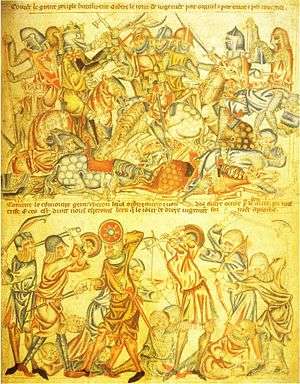
Edward II and his advisors were aware of the places the Scots were likely to challenge them and sent orders for their troops to prepare for an enemy established in boggy ground near the River Forth, near Stirling.[10] The English appear to have advanced in four divisions, whereas the Scots were in three divisions known as 'schiltrons', which were strong defensive circles of men bristling with pikes.[10] Thomas Randolph, 1st Earl of Moray, commanded the Scottish vanguard, which was stationed about a mile south of Stirling, near the church of St. Ninian, while the king commanded the rearguard at the entrance to the New Park. His brother Edward led the third division. According to Barbour, there was a fourth division nominally under the youthful Walter the Steward, but actually under the command of Sir James Douglas.[12] The Scottish archers used yew-stave longbows and, though these were not weaker than or inferior to English longbows, there were fewer Scottish archers than English archers,[13] possibly numbering only 500. These archers played little part in the battle.[14] There is firsthand evidence in a poem by the captured Carmelite friar Robert Baston, written just after the battle, that one or both sides employed slingers and crossbowmen.[15]
Battle
Location of the battlefield
The exact site of the Battle of Bannockburn has been debated for many years,[16] but most modern historians agree that the traditional site,[17] where a visitor center and statue have been erected, is not correct.[18]
A large number of alternative locations have been considered, but modern researchers believe only two merit serious consideration:[19]
- An area of peaty ground outside the village of Balquhiderock known as the Dryfield, about .75 miles (1.21 km) east of the traditional site.[20]
- The Carse of Balquhiderock, about 1.5 miles (2.4 km) northeast of the traditional site. This location is accepted by the National Trust as the most likely site.[21]
First day of battle

Most medieval battles were short-lived, lasting only a few hours, so the Battle of Bannockburn is unusual in that it lasted two days.[10] On 23 June 1314 two English cavalry formations advanced. The first was commanded by the Earl of Gloucester and by the Earl of Hereford.[10]
They encountered a body of Scots led by Robert the Bruce.[10] Bruce and Henry de Bohun, the nephew of the Earl of Hereford, faced off in what became a celebrated instance of single combat.[10] Bohun charged at Bruce and when the two passed side by side, Bruce split Bohun's head with his axe.[10][22] The Scots then rushed the English forces under Gloucester's and Hereford's command, who retreated, struggling back over the Bannockburn.[23]
The second English cavalry force was commanded by Robert Clifford and Henry de Beaumont. Their forces included Sir Thomas de Grey of Heaton, father of the chronicler Thomas Grey. The younger Grey described the battle:
Robert Lord de Clifford and Henry de Beaumont, with three hundred men-at-arms, made a circuit upon the other side of the wood towards the castle, keeping the open ground. Thomas Randolph, 1st Earl of Moray, Robert de Brus's nephew, who was leader of the Scottish advanced guard, hearing that his uncle had repulsed the advanced guard of the English on the other side of the wood, thought that he must have his share, and issuing from the wood with his division marched across the open ground towards the two afore-named lords.
Sir Henry de Beaumont called to his men: "Let us wait a little; let them come on; give them room".
"Sir," said Sir Thomas Gray, "I doubt that whatever you give them now, they will have all too soon".
"Very well" exclaimed the said Henry, "if you are afraid, be off".
"Sir," answered the said Thomas, "it is not from fear that I shall fly this day."
So saying, he spurred in between Beaumont and Sir William Deyncourt and charged into the thick of the enemy. William was killed, Thomas was taken prisoner, his horse being killed on the pikes, and he himself carried off with the Scots on foot when they marched off, having utterly routed the squadron of the said two lords. Some of the English fled to the castle, others to the king's army, which having already left the road through the wood had debouched upon a plain near the water of Forth beyond Bannockburn, an evil, deep, wet marsh, where the said English army unharnessed and remained all night, having sadly lost confidence and being too much disaffected by the events of the day.
— Sir Thomas Gray, Scalacronica, translated by Herbert Maxwell[24]
Second day of battle
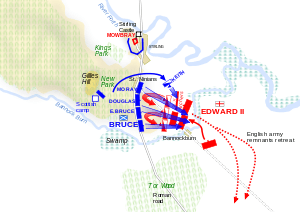
During the night the English forces crossed the stream known as the Bannockburn, establishing their position on the plain beyond it.[10] A Scottish knight, Alexander Seton, who was fighting in the service of Edward II of England, deserted the English camp and told Bruce that the English morale was low and encouraged him to attack.[10]
In the morning the Scots advanced from New Park.[10] Not long after daybreak, Edward was surprised to see the Scottish pikemen emerge from the cover of the woods and advance towards his position. As Bruce's army drew nearer, they paused and knelt in prayer. Edward reportedly said in surprise, "They pray for mercy!" "For mercy, yes," one of his attendants replied, "but from God, not you. These men will conquer or die."[25]
The Earl of Gloucester had argued with the Earl of Hereford over who should lead the vanguard into battle. He had also tried to persuade the king that the battle should be postponed. This led the king to accuse him of cowardice. Goaded by the accusation, the Earl of Gloucester advanced to meet the Scottish.[10] Few accompanied Gloucester and when he reached the Scottish lines he was quickly surrounded and killed.[10]
The English were gradually pushed back and ground down by the Scots' schiltrons.[10] The English longbowmen attempted to support the advance of the knights but were ordered to stop shooting, as they were causing casualties among their own. The English then attempted to deploy their English and Welsh longbowmen to flank the advancing Scots, but they were dispersed by 500 Scottish cavalry under the Marischal Sir Robert Keith.[26] (Although the Scottish cavalry are sometimes described as light cavalry, this appears to be a misinterpretation of Barbour's statement that these were men-at-arms on lighter horses than their English counterparts.[27])
The English cavalry was hemmed in against the Bannockburn, making it difficult for them to maneuver.[10] They were unable to hold their formations and broke ranks.[10] It soon became clear to Aymer de Valence and Giles d'Argentan (reputedly the third best knight in Europe) that the English had lost the battle and Edward II needed to be led to safety at all costs. Seizing the reins of the king's horse, they dragged him away, closely followed by 500 knights of the royal bodyguard.[28]
Once they were clear of the battle d'Argentan turned to the king, said, "Sire, your protection was committed to me, but since you are safely on your way, I will bid you farewell for never yet have I fled from a battle, nor will I now." He turned his horse to charge back into the ranks of Scottish where he was overborne and slain.[29]
English retreat
Edward fled with his personal bodyguard, and panic spread among the remaining troops, turning their defeat into a rout. Edward arrived eventually at Dunbar Castle, from which he took a ship to Berwick. From the carnage of Bannockburn, the rest of the army tried to escape to the safety of the English border, 90 miles (140 km) to the south. Many were killed by the pursuing Scottish army or by the inhabitants of the countryside they passed through.
Historian Peter Reese wrote that "only one sizeable group of men — all foot soldiers — made good their escape to England."[9] These were a force of Welsh spearmen who were kept together by their commander, Sir Maurice de Berkeley. The majority of them reached Carlisle.[9] Weighing the available evidence, Reese concludes that "it seems doubtful if even a third of the foot soldiers returned to England."[9] If accurate, of 16,000 English infantrymen, about 11,000 were killed. The English chronicler Thomas Walsingham gave the number of English men-at-arms who were killed as 700,[7] while 500 more men-at-arms were spared for ransom.[30] The Scottish losses appear to have been comparatively light, with only two knights among those killed.[31]
Aftermath
The defeat of the English opened up the north of England to Scottish raids[10] and allowed the Scottish invasion of Ireland.[26] These finally led, after the failure of the Declaration of Arbroath, to reach this end by diplomatic means, to the Treaty of Edinburgh–Northampton.[26] Under the treaty the English Crown recognised the full independence of the Kingdom of Scotland, and acknowledged Robert the Bruce, and his heirs and successors, as the rightful rulers.
Notable casualties
Deaths
- Gilbert de Clare, 8th Earl of Gloucester
- Sir Giles d'Argentan
- John Lovel, 2nd Baron Lovel
- John Comyn, Lord of Badenoch
- Robert de Clifford, 1st Baron de Clifford
- Sir Henry de Bohun
- William le Marshal, Marshal of Ireland
- Edmund de Mauley, King's Steward
- Sir Robert de Felton of Litcham, 1st Lord
- Malduin (Malcolm) MacGilchrist, 3rd Lord of Arrochar
Captives
- Humphrey de Bohun, 4th Earl of Hereford
- John Segrave, 2nd Baron Segrave
- Maurice de Berkeley, 2nd Baron Berkeley
- Thomas de Berkeley
- Sir Marmaduke Tweng
- Ralph de Monthermer, 1st Baron Monthermer
- Robert de Umfraville, Earl of Angus
- Sir Anthony de Luci
- Sir Ingram de Umfraville
- Sir John Maltravers, 1st Baron Maltravers
- Sir Thomas de Grey of Heaton
Legacy
Bannockburn Visitor Centre
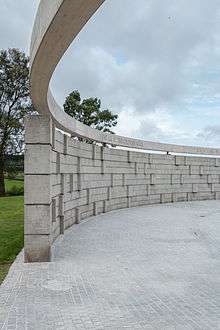
In 1932 the Bannockburn Preservation Committee, under Edward Bruce, 10th Earl of Elgin and Kincardine, presented lands to the National Trust for Scotland. Further lands were purchased in 1960 and 1965 to facilitate visitor access. A modern monument was erected in a field above the possible site of the battle, where the warring parties are believed to have camped on the night before the battle. The monument consists of two hemicircular walls depicting the opposing parties. Nearby stands the 1960s statue of Bruce by Pilkington Jackson. The monument, and the associated visitor centre, is one of the most popular tourist attractions in the area. The battlefield has been included in the Inventory of Historic Battlefields in Scotland and protected by Historic Scotland under the Historic Environment (Amendment) Act 2011.[32]
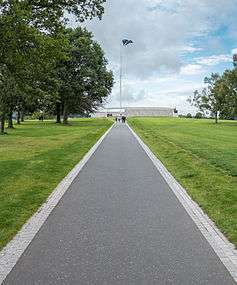 Alley to the monument
Alley to the monument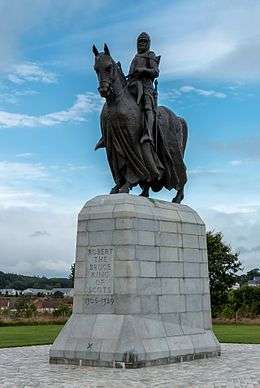 Statue of Robert the Bruce by Pilkington Jackson
Statue of Robert the Bruce by Pilkington Jackson View of the circular walls and the flag pole
View of the circular walls and the flag pole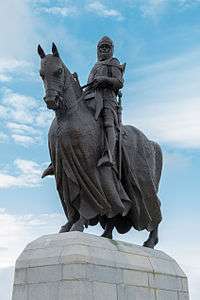 Close Up of the statue
Close Up of the statue
The National Trust for Scotland operates the Bannockburn Visitor Centre (previously known as the Bannockburn Heritage Centre), which is open daily from March through October. On 31 October 2012 the building was closed[33] for demolition and replacement by a new design, inspired by traditional Scottish buildings, by Reiach and Hall Architects. The project is a partnership between the National Trust for Scotland and Historic Scotland, funded by the Scottish Government and the Heritage Lottery Fund.[34] The battlefield's new visitor centre - now rebranded as the Bannockburn Visitor Centre - opened in March 2014. One of the attractions created by a £9m redevelopment of the centre and the nearby battlefield memorial is a computerised multiplayer game.[35]
Arts
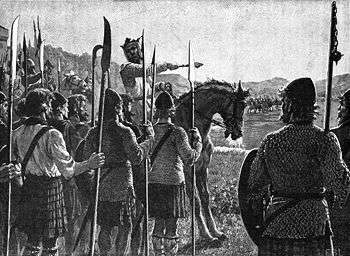
"Scots Wha Hae" is the title of a patriotic poem by Robert Burns.[37] The chorus of Scotland's unofficial national anthem Flower of Scotland refers to Scotland's victory over Edward and the English at Bannockburn. Many artworks depict the battle. John Duncan[38] and Eric Harald Macbeth Robertson[39] both painted Bruce's encounter with de Bohun. John Phillip painted Bruce receiving the sacrament on the eve of the battle.[40] John Hassall painted a similar theme.[41] William Findlay also depicts Bruce at the battle.[42]
The Swedish power metal band Sabaton wrote the song Blood of Bannockburn on their album The Last Stand.
References
- ↑ Nusbacher, Aryeh (2000). The Battle of Bannockburn 1314. Stroud: Tempus. p. 85. ISBN 0-7524-1783-5.
- ↑ Oman, Charles (1991) [1924]. A History of the Art of War in the Middle Ages Vol. II. London: Greenhill Books. p. 88. ISBN 1-85367-105-3.
- ↑ Armstrong, Pete (2002). Bannockburn. Botley, Oxford: Osprey Publishing. p. 43. ISBN 1-85532-609-4.
- ↑ Grant, R.G. (2008), Battle: A visual journey through 5,000 years of combat, DK Publishing,p.118.
- ↑ Sadler, John, Scottish Battles, (Biddles Ltd., 1998), 52–54.
- ↑ Grant, 118.
- 1 2 Mackenzie, p.88 referencing Walsingham, p.141
- ↑ Sadler, 52.
- 1 2 3 4 Reese, p.174
- 1 2 3 4 5 6 7 8 9 10 11 12 13 14 15 16 17 18 19 20 21 22 23 24 25 26 27 Black, Jeremy. (2005). The Seventy Great Battles of All Time. pp. 71–73. Thames & Hudson Ltd. ISBN 0-500-25125-8.
- ↑ Watson, F., "In Our Time: The Battle of Bannockburn", BBC Radio, 3 February 2011
- ↑ Nicholson, Later Middle Ages pp.87–89
- ↑ Strickland, Matthew; Hardy,Robert (2005). The Great Warbow. Stroud: Sutton. p. 162. ISBN 0-7509-3167-1.
- ↑ The Chronicle of Lanercost says that on the second day of the battle, "the English archers were thrown forward before the line, and the Scottish archers engaged them, a few being killed and wounded on either side; but the King of England's archers quickly put the others to flight." The Chronicle of Lanercost, 1272–1346: Translated, with notes by Sir Herbert Maxwell. p. 206
- ↑ Walter Bower, Scotichronicon,Book XII, p. 371
- ↑ Historic Environment Scotland. "Battle Of Bannockburn (47243)". Canmore. Retrieved 2009-04-02.
- ↑ "OS 25 inch map 1892-1949, with Bing opacity slider". National Library of Scotland. Ordnance Survey. Retrieved 12 October 2017.
- ↑ Mackenzie, W. M. (1913). The Battle of Bannockburn: a Study in Mediaeval Warfare, Publisher: James MacLehose; Glasgow.
- ↑ Barrow, Geoffrey W.S. (1998). Robert Bruce & The Community of The Realm of Scotland. ISBN 0-85224-604-8
- ↑ Barron, E.M., The Scottish War of Independence: a Critical Study, 1934
- ↑ Christison, Philip, Bannockburn: The Story of the Battle, 1960, Edinburgh: The National Trust for Scotland.
- ↑ Hyland, Ann. The Warhorse 1250–1600, UK: Sutton Publishing, 1998, p 38
- ↑ The Battle of Bannockburn britishbattles.com. Retrieved 14 June 2014.
- ↑ Maxwell 1907
- ↑ Scott 1982, p. 158
- 1 2 3 Scott 1982
- ↑ (Brown, C. (2008) pp 129-130)
- ↑ Scott 1982, p. 159
- ↑ Scott 1982, p. 160
- ↑ Mackenzie, p.90
- ↑ Reese, p.176
- ↑ "Inventory battlefields". Historic Scotland. Retrieved 2012-04-12.
- ↑ "Bannockburn Heritage Centre closes before demolition". BBC News. 31 October 2012. Retrieved 31 October 2012.
- ↑ "Battle of Bannockburn: Bannockburn : About the project".
- ↑ "Battle of Bannockburn: : The Battle of Bannockburn Visitor Centre Opens".
- ↑ Arnold-Foster, Hugh Oakley (1907). "Bannockburn". A History of England from the Landing of Julius Caesar to the Present Day. London, Paris, New York & Melbourne: Cassell and Company. p. 207. Retrieved 2009-06-19.
- ↑ The Complete Works of Robert Burns at Project Gutenberg.
- ↑ "Bruce and De Bohun". ArtUK. The Stirling Smith Art Gallery & Museum. Retrieved 5 November 2017.
- ↑ "Robert the Bruce and de Bohun". ArtUK. The Fleming Collection. Retrieved 5 November 2017.
- ↑ "Robert the Bruce on the Eve of Bannockburn Receiving the Sacrament from the Abbot of Inchaffre". ArtUK. Brechin Mechanics' Institute. Retrieved 5 November 2017.
- ↑ "Bannockburn". ArtUK. Kelvingrove Art Gallery and Museum. Retrieved 5 November 2017.
- ↑ "The Liberation of Scotland (The Battle of Bannockburn)". ArtUK. Glasgow Museums Resource Centre (GMRC). Retrieved 5 November 2017.
Sources
Primary
- Barbour, John, The Brus, trans. A. A. M. Duncan, 1964.
- Bower, Walter, Scotichronicon, ed. D. E. R. Watt, 1987–1993.
- Maxwell, Herbert, trans. (1907). Scalacronica; The reigns of Edward I, Edward II and Edward III as Recorded by Sir Thomas Gray. Glasgow: James Maclehose & Sons. Retrieved 17 October 2012.
- Lanercost Chronicle, edited and translated by H. Maxwell, 1913.
- Vita Edwardi Secundi (Life of Edward the Second), ed. N. D. Young, 1957.
- Walsingham, Thomas, Historia Anglicana.
Secondary
- Armstrong, Pete (illustrated by Graham Turner), Bannockburn 1314: Robert Bruce's Great Victory, Osprey Publishing, 2002 ISBN 1-85532-609-4
- Barrow, G. W. S., Robert Bruce and the Community of the Realm of Scotland, 1988, ISBN 0-85224-604-8
- Brown, C.A., "Bannockburn 1314",History Press,Stroud, 2008, ISBN 978-0-7524-4600-4.
- Brown, C.A., Robert the Bruce. A life Chronicled.
- Brown, Michael (2008). Bannockburn. The Scottish War and the British Isles 1307-1323. Edinburgh: Edinburgh University Press.
- Brown, M., Wars of Scotland

- Mackenzie, W. M., Bannockburn: A Study in Medieval Warfare, The Strong Oak Press, Stevenage 1989 (first published 1913), ISBN 1-871048-03-6
- MacNamee, C., The Wars of the Bruces
- Nicholson, R., Scotland-the Later Middle Ages, 1974.
- Prestwich, M., The Three Edwards: War and State in England, 1272–1377, 1980
- Ramsay, J. H., The Genesis of Lancaster, 1307–99, 1913.
- Reese, P., Bannockburn, Canongate, Edinburgh, 2003, ISBN 1-84195-465-9
- Scott, Ronald McNair (1982). Robert the Bruce King of Scots. London: Hutchinson & Co.